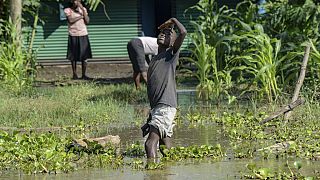Kenya
Nakuru County lies within East Africa’s vast Rift Valley. Hundreds of thousands of people here are suffering from acute water shortages, made much worse by drought.
Volcanic and tectonic activity in the rift started about 30 million years ago and the area is still geologically active, with volcanoes, hot springs, and geysers. Now local communities here are embracing this local resource.
In Eburru Mbaruk, volcanic activity makes it dangerous to dig wells and loose soil and low water tables mean they collapse very quickly. Local residents now embark on a long and laborious process of searching for geysers.
Where the geysers look as though they might produce water, the villagers dig five feet below the ground and trap the steam which condenses into water. The source of water here led to the Camp Brethren Christian School setting up its secondary school at this location.
The school’s accountant Paul Nduthu says: "The geothermal steam is very important to the school. When we first set up our primary school, we had a lot of problems with water and that’s why we chose this place as a site for our secondary school. The steam water is all year round, we also supplement it with rainwater, but rainwater comes during the rainy season and after some time it gets depleted, but the steam water runs throughout, and also it is safe for drinking."
The bigger the pipes and tanks, the greater amount of water can be collected.
Freshwater rivers are few and far between, and without the geothermal tanks people would be forced to walk long distances to collect water. The pipes are connected to huge slanting tanks above the ground where steam condenses to water.
To increase the amount of steam condensing, the tanks are fitted with long slanting metallic pipes through which cold air enters the tank, condensing more steam to water and also allowing residual steam to escape. The residents mainly use aluminium sheets to construct pipes and tanks because the material does not rust.
Lake Naivasha, a freshwater lake in Nakuru, is heavily polluted by neighbouring flower farms and cannot be used for domestic purposes. Local resident Douglas Chege says: "The area is so much contaminated; we have the greenhouses around that area and this water is running towards that lake.
"When we get that water from that (lake) the water will be too much contaminated for our domestic use. So the government came up with this point of just getting this water," says Chege.
But it's unclear whether demand for water can be met using this system. Another resident Patricia Nyaguthii says: "Though it is clean water, it is very little and it is not enough but we do not have any other source of water. It is a long time since it rained."
Kenya Electricity Generating Company (KenGen), an electricity power plant in the region, does provide piped water, but residents says it’s untreated and exposes them to water-borne diseases.
Since only a few locations have enough steam to be tapped, the government of Kenya has allocated communal land where villagers harvest steam.
Steven Okoth, a geologist at the Ministry of Water, Sanitation and Irrigation explains the causes of geothermal steam jets. He says the seismic activity creates cracks in the Earth’s crust.
"So, the area is rifting, it is tearing apart, that is what is called the rift and when it is tearing apart, there is the magma in this area which is the source of heat in this area and then where there is rifting there are also a lot of fractures. There is a lot of fracturing which is taking place when the rifts are formed,” says Okoth.
According to Okoth, water flowing from Mau forest is swallowed up by surface fractures which is why the region lacks visible rivers. Okoth further explains that geothermal steam water is renewable.
“So it is renewable, as long as there is still rain in the Mau and water is flowing into these fractures, it will be renewed, the water will be renewed and when there is still hot molten rock, it will continuously heat the water which is flowing,” says Okoth.
It's good news for residents who rely on geothermal steam for clean, safe water.











01:00
Pics of the day: April 17, 2024
01:13
Kenya power delivers cheaper electricity bills for residents
Go to video
Hellen Obiri claims back-to-back Boston Marathon titles, leading Kenyan women's podium sweep
01:04
Kenya proposes treaty to ease Somalia-Ethiopia tensions
11:10
Coltan: at the heart of DRC-Rwanda tensions [Business Africa]
01:08
Moderna puts Kenya plant plans on hold